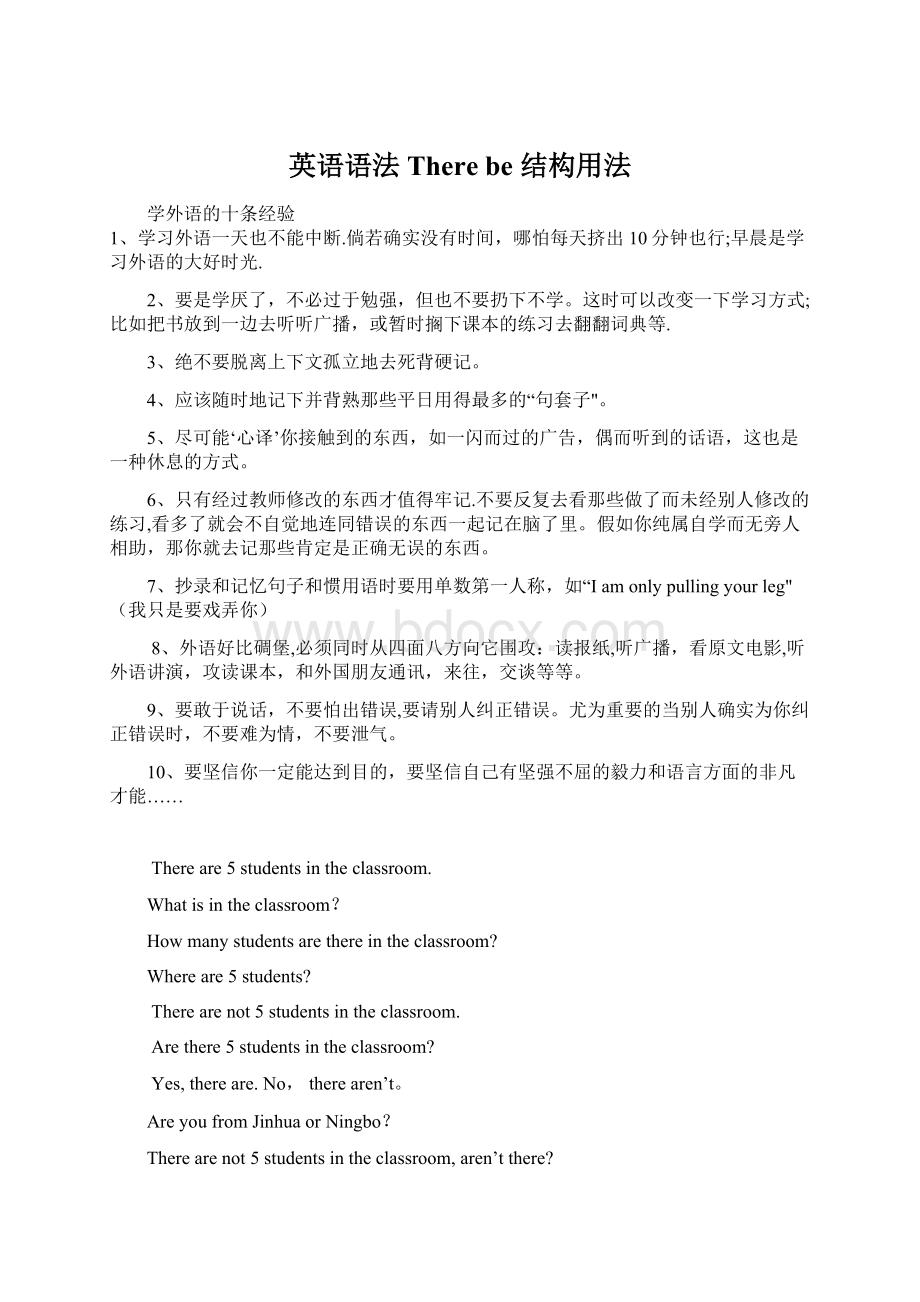英语语法There be 结构用法Word下载.docx
《英语语法There be 结构用法Word下载.docx》由会员分享,可在线阅读,更多相关《英语语法There be 结构用法Word下载.docx(19页珍藏版)》请在冰豆网上搜索。

Therebe句型
1。
定义:
Therebe句型表示某处存在某物或某人.
2.结构:
(1)Thereis+单数可数名词/不可数名词+地点状语。
Thereisanappleonthetable。
Thereissomewaterinthebottle.
(2)Thereare+复数名词+地点状语。
Thereare2booksinmybag。
there是引导词,在句中不充当任何成分,翻译时也不必译出。
句子的主语是某人或某物,谓语动词be要与主语(某人或某物)的数保持一致。
当主语是两个或两个以上的名词时,谓语动词要与跟它最近的那个名词一致—-—就近原则。
eg.
①Thereisabirdinthetree。
树上有一只鸟。
②Thereisateacherandmanystudentsinourclassroom。
我们教室里有一位老师和许多学生.
③Therearetwoboysandagirlunderthetree。
树下有两个男孩,一个女孩。
3。
Therebe句型与have的区别:
(1)Therebe句型和have都表示“有”的含义。
区别如下:
Therebe表示“某处存在某物或某人”;
have表示“某人拥有某物/某人"
,它表示所有、拥有关系.
eg。
①Hehastwosons.
他有两个儿子。
②Therearetwomenintheoffice.
办公室里有两个男人。
(2)当have表示“包括”、“存在”的含义时,Therebe句型与其可互换。
Aweekhassevendays.=Therearesevendaysinaweek.
一个星期有七天。
一、否定句
Therebe句型的否定式的构成和含有be动词的其它句型一样,在be后加上not即可.注意not是副词
例如:
Therearesomepicturesonthewall。
→Therearen’tanypicturesonthewall。
=Therearenopicturesonthewall.
Thereisabikebehindthetree.→Thereisn'
tabikebehindthetree。
=Thereisnobikebehindthetree.
二、一般疑问句
Therebe句型的一般疑问句变化是把be动词调整到句首,再在句尾加上问号即可,此为\"
调整法\”.但同时要注意:
当肯定句中有some时,要将其改为any(否定变化也一样)。
看看下面两句是如何改变的:
ThereissomewateronMars.→IsthereanywateronMars?
Therearesomefishinthewater.→Arethereanyfishinthewater?
三、特殊疑问句
Therebe句型的特殊疑问句形式有以下三种变化:
①对主语提问:
当主语是人时,用”Who'
s+介词短语?
"
;
当主语是物时,用"
What'
s+介词短语?
”。
注意:
无论原句的主语是单数还是复数,对之提问时一般都用be的单数形式(回答时却要根据实际情况来决定).如:
Therearemanythingsoverthere。
→What’soverthere?
Thereisalittlegirlintheroom。
→Whoisintheroom?
②对地点状语提问:
提问地点用"
Whereis/are+主语?
"
Thereisacomputeronthedesk.→Whereisthecomputer?
Therearefourchildrenontheplayground.→Wherearethefourchildren?
③对数量提问:
一般有两种句型结构:
Howmany+复数名词+arethere+介词短语?
Howmanybooksarethereonthedesk?
Howmuch+不可数名词+isthere+介词短语?
Howmuchmoneyisthereinyourpocket?
Therebe结构在英语中是一个常见的句子结构,组成为“引导词there+be+主语+状语”.
句子的特殊用法较多,下面就therebe结构归纳如下:
There和live,lie,come,stand,exit,remain,happen,enter等表示存在、状态的动词连用.
例:
Thereoncelivedanoldfishermaninavillagebythesea.
Therestandsabigtreeonthetopofthemountain。
Therehappenedanevent.
Therecameshoutsforhelpfromthatriver。
Thereliesalargetreeinfrontofouroffice.
2.There和情态动词连用,使存在的状态更加具体化、形象化,描述的语气多样化.
Theremaybe3500studentsinourschool.
Theremustbesomemistakes。
Thereoughttobenotrouble。
Thereusedtobeatemplehere.
3.There和seemtobe,appeartobe,happentobe,beboundtobe,belikelytobe等连接,表示“碰巧有”、“可能有"
、“一定有”。
Therehappenedtobeanoldfriendofmineinthefactory.
Thereseemstobesomethingwrongwithit。
4。
Therebe+名词,它的后面可以接状语、定语从句、不定式结构或ing分词和ed分词结构.
Therearemanyreasonsforanimalsdyingout。
TherewillbeanEnglishpartyinourschoolthisevening.
Therearealwaysnewthingstobediscovered.
Thereweremanypeopleinthestreetwatchingthefilm。
注:
如有两个或两个以上并列主语时,be常与最靠近的主语在人称和数上一致.
Thereisonlyatable,fourchairsandasmallbedintheroom。
5.itis和therebe结构比较:
itis和therebe句型的区别要通过具体的环境来看,有时意义相同,有时含义差距较大。
Itiswindytoday。
=Thereisawindtoady.(Itis+形容词,therebe+名词)
ItisalongwayfromBeijingtoShanghai。
从北京到上海路程很远。
Thereisstillalongwaytogo.还有很长的路要走。
Thereissomeoneatthedoor.Ithinkitisthemantodeliverthepapers.
Thereisnodoubtthatheisnotathomenow.毫无疑问他现在不在家。
Therebe句型练习
一.根据所给汉语完成句子.
1.桌子上有一本书和两支钢笔。
There_____abookandtwopensonthedesk。
2。
钱包里有些钱.There____somemoneyinthewallet。
在吉姆的书包里有一些卡片。
_________somecardsinJim'
sbag。
4.里面还有其他的东西吗?
__________anythingelseinit?
5。
我们学校有许多班。
There_____many_____inourschool.
6.树上没有鸟。
There__are_not/no___birdsinthetree.
二。
选择填空:
Arethereanymapsonthewall?
___
A。
Yes,therearesome.
B。
Yes,thereis。
C。
Yes,thereisone。
D.No,thereare.
2.Howmany____arethereinthepicture?
A.womanB.womenC.buyD.milk
Therearen’t___treesnearthehouse。
Thereisonlyone。
A.any
B.someC.manyD.much
There___twobowlsofriceonthetable.
A。
isB.haveC.hasD.are
5.Arethere___housesneartheriver?
Yes,thereare
.
A.some,some
B.any,some
C。
any,any
D.some,any
三.句型转换:
Thereisawomannearthehouse。
(变复数)
Therearemanywomennearthehouse.
Therearesomebusesnearthehill.(变单数)
Thereisabusnearthehill.
3.Therearesomeapplesinthetree。
(变一般问句)
Arethereanyapplesinthetree?
Therearesomeorangesintheglass。
(变否定句)
Therearenotanyorangesintheglass.
5.Isthereababyintheroom?
Aretherebabiesintheroom?
6.Therearemanybeautifulflowersinthegarden.(就划线部分提问)Whatisinthegarden?
7.Thereisabookcaseinmystudy。
(变一般问句)
_Isthereabookcaseinyourstudy?
8.Thereisasoccerballandabasketballonthefloor.
___What’sonthefloor?
9.Mynewdressisinthewardrobe。
____Whereisyournewdress?
10.Therearesomebigtreesbehindmyhouse.
__Whereare_the_bigtrees?
四。
therebe与have区别专练。
1.Thisdesk__has___fourlegs.
2.__Thereare____somebooksonthedesk。
Everyone___has___adictionaryinmyclass.
4.Therearenot/no_(没有)knivesintheroom。
5.I__have___anewsweater.
6._Thereare_____someflowersandadeskintheroom.
7.Thereisnothinginthebag。
8.They__have_somethingtoeat。
反意疑问句的特殊用法
反意疑问句的句型结构是:
陈述句+附加问句”.附加问句部分与陈述句部分在人称.时态和数等方面须一致,而且”前否后肯,前肯后否"
在做反意疑问句改写时应特别注意下列情况:
1.陈述句部分的主语是one时,附加问句部分主语正式场合用one,非正式场合用he.例如:
Oneshoulddoone'
sbestforthework,shouldn'
tone(he)?
Onemustdoone’sduty,needn’tone(he)?
MustIcome?
Yes,youmust.No,youneedn’t.
2。
陈述句部分是I’m。
时,附加问句部分常用aren'
tI?
I’mtwelve,aren’tI?
I'
magooddriver,aren’tI?
3.陈述句部分是therebe时,附加问句部分也要用there。
例如:
Thereissomemilkinthebottle,isn’tthere?
TherearemanypeopleintheparkonSunday,aren'
tthere?
陈述句部分以let'
s开头时,附加问句部分要用shallwe;
若以letus开头时,附加问句部分要用willyou?
Let’shaveabreak,shallwe?
Letusstophere,willyou?
5.陈述句部分的主语是everybody,everyone,someone,anyone,noone,
nobody,somebody等不定代词时,附加问句部分可用he,也可用they。
Everyoneknowshisownlanguage,doesn’the?
Everybodyenjoyedthefilm,didn’t
he/they?
6.陈述句部分有never,none,nothing,no等否定词或few,little,hardly等半否定词时,附加问句部分要用肯定形式。
Youneverreadthisnovel,doyou?
Fewpeoplecanliveto150,canthey?
7.当陈述句部分是一个含有从句的主从复合句时,附加问句部分的形式要看主句,其主语及动词都要与主句保持一致。
Hesayssheisagoodteacher,doesn'
the?
Theysaidtheteacherhadleft,didn'
tthey?
但当主句是Ithink,Ibelieve等结构时,附加问句部分形式要看从句。
Ithinksheisallrightnow,isn’tshe?
Idon’tbelieveheishere,ishe?
8。
陈述句部分是祈使句的否定形式时,附加问句部分常用willyou?
例如:
Don’tmakeanynoise,willyou?
反意疑问句是指先陈述一件事,再用省略的一般疑问句附加在其后构成的疑问句。
通常用yes/no回答.
对于反意疑问句,我们必须知道的基本规则:
1、反意疑问句的陈述部分如果是肯定,附加的一般疑问句就用否定形式;
如果陈述部分是否定,则附加部分用肯定形式.
(我们可以这样记忆这条规则:
前肯后否,前否后肯)
如:
Thisisabook,isn’tit?
Thisisnotabook,isit?
YoucanspeaksomeEnglish,can’tyou?
Youcan’tspeakanyEnglish,canyou?
2、反意疑问句的附加部分(疑问句)的主语一定要用人称代词充当(前句为therebe句型除外,在那样的情形里,句尾还用there),如果后部分是否定,一定要用缩写形式。
(前部分为Iam…时,后部分用aren’tI?
)
如:
Iamateacher,aren’tI?
Therewillbeameeting,won'
3、如何回答反意疑问句对于很多同学来说可能会是一个问题,因为在这点上英语和汉语的习惯不同。
下面我们来进行对比。
汉语:
“你不是一个老师,是吗?
”
英语:
Youaren'
tateacher,areyou?
No,I’mnot。
“是的,我不是老师。
”
Yes,Iam。
不,我是老师.
通过对比,我们可以发现汉语的答语可以前面是否定、后面是肯定,而英语绝对不行,前后必须一致,要么全部用肯定,要么全部用否定。
回答反意疑问句的时候,总是先考虑答语的后部分到底该用肯定还是否定,然后再给这个答语的前面加上Yes或者No。
其它规则:
1.陈述部分里的代词noone(nobody)、everyone(everybody)、someone(somebody)、anyone(anybody)等,在最后部分用he或者they代替.
如:
Everyoneshouldworkhard,shouldn'
the/they?
2.must作必须讲,后部分用must或者need;
mustnot作禁止讲,后部分用may.
如:
Wemustkeepquietinthelibrary,mustn’t/needn’twe?
Theymustnotparktheircarshere,maythey?
3.有时候前面的陈述部分看似陈述形式,但其中含有seldom(不常)、hardly(几乎不)、nobody(没人)、nothing(没有什么)、never(从不)、none(一个也没有)、neither(两者都不)、few(几乎没有)、little(几乎没有)等表示否定意义的词,此时要把陈述部分看成否定,其后的附加疑问句要用肯定形式;
某些句子里含有dis-或者un-这样表示否定意义的前缀的复合词(如dislike和unusual),还是要把它看成肯定句.
Heisneverlateforschool,ishe?
Hecanhardlybelieveyou,canhe?
Thereisnothingnewintoday’snewspaper,isthere?
Itseldomrainshereinspring,doesit?
Itisveryunusual,isn’tit?
4.“(Don'
t)+动词原形+其他”这样的祈使句无论否定还是肯定,反意疑问句的疑问部分都用“willyou”。
Openthedoor.—Openthedoor,willyou?
Don'
ttalkinclass。
—Don’ttalkinclass,willyou?
5.Let'
sdo和Letusdo
Let’s…(包含对方,所以后部分用shallwe?
Letus…(不包含对方,所以后部分用willyou?
Let'
splayfootball,shallwe?
这句话的含义是说话者邀请听话人和他一起去踢足球,所以后部分用人称代词we。
Letusplayfootball,willyou?
这句话的含义是说话者请求听话人允许他去踢足球,所以后部分用人称代词you。
6.把感叹句看成一般意义的陈述句,然后照一般的规则处理.
Whatagoodboyh